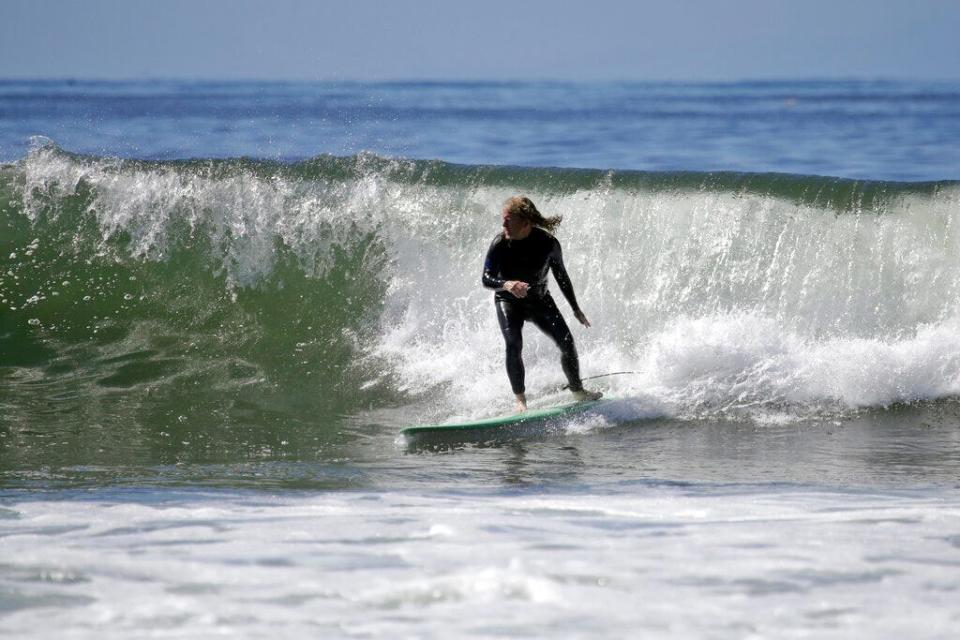Los Angeles County reopens beaches closed by virus concerns but sunbathing is off-limits
Los Angeles County reopened its beaches Wednesday in the latest cautious easing of coronavirus restrictions that have closed most California public spaces and businesses for nearly two months.
County beaches and many city-owned beaches along the 75 miles of coastline are open only for “active recreation” such as walking, swimming and surfing. Sunbathing, picnicking and group sports such as volleyball are still banned and strangers must stay well apart. Visitors also must wear masks when they’re out of the water.
Turnout was mixed on a bright morning: Surfers caught waves as locals walked the waterline at Manhattan Beach while windy Venice Beach was all but empty. County lifeguards spokesman Kealiinohopono “Pono” Barnes said that was likely due to the mid-week opening and people working from home.
Some mayors warned that the state or county could close the beaches again if people disobey the restrictions and crowd the shoreline.
“Please, hit the beach, do your thing, and leave. No hanging out for this first phase,” Redondo Beach Mayor Bill Brand urged in a Facebook post.

The move comes as California, which is still seeing a rise in COVID-19 cases, tentatively eases some stay-at-home restrictions.
Democratic Gov. Gavin Newsom last week permitted tens of thousands of retail businesses to reopen under restrictions. On Tuesday, he said business offices can reopen with appropriate precautions if their employees cannot easily telecommute, while malls can begin offering the same curbside pickup already allowed for other retailers.
Pressure is building to reopen more quickly than Newsom’s four-stage plan — still in its second phase. Three northern counties — Sutter, Yuba and Modoc — have defied the rules and permitted gyms, hair salons and dine-in restaurants to reopen without state permission.
On Tuesday, the Professional Beauty Federation of California sued Newsom and his administration, calling the rules vague and arbitrary and arguing that they are “criminalizing the jobs these 500,000-plus state-licensed professionals perform in every community.”
Meantime, seven rural Northern California counties — El Dorado, Butte, Lassen, Nevada, Placer, Amador and Shasta — that have not had a single virus death were the first to win state permission to reopen their economies. Each certified they have had minimal impact from the pandemic, have plans for a safe reopening and can adequately react if there is a resulting surge in infections.
Twenty-three more of California’s 58 counties are negotiating with state health officials to move more swiftly, according to Newsom. They include Sutter and Yuba counties.
San Diego County, California’s second-largest, complained in a letter to Newsom on Monday that the state’s criteria for a more rapid reopening are unrealistic for large counties.
Newsom acknowledged the complexity of a patchwork reopening. “We have different counties experiencing completely different conditions, and we are now in that phase of trying to accommodate for all of that and more,” he said.
Los Angeles County, which has roughly a quarter of California’s population but than half of the state’s 2,800 deaths, is taking a more cautious approach, although it followed the state’s lead in reopening retail businesses last weekend.
County Public Health Director Dr. Barbara Ferrer said Tuesday that she expects to extend the county’s stay-at-home order for three months, though she said restrictions will gradually be relaxed under a five-stage “roadmap to recovery.”
Los Angeles Mayor Eric Garcetti supported gradual change. “We’re not moving past COVID-19, we’re learning to live with it — and we will keep taking measured steps toward a new, safer reality in the days and weeks ahead,” he said.
Piers and parking lots remain closed, including some of the county’s main oceanside tourist attractions such as the Venice Beach boardwalk and the Santa Monica and Redondo Beach piers.
Santa Monica Beach Bicycle Rentals is located four blocks from the beach and the business has been closed since March 10. Owner Rob Wakefield didn’t plan to reopen Wednesday because the city’s bike path is still closed but he called the beach opening a good sign.
“The last thing we want to do is get somebody infected. We don’t want to get infected either,” he said. “That comes before the mighty dollar ... for us, anyway.”
Some cities plan to have lifeguards or police warn people to obey the social distancing rules and violators might even face fines or prosecution.
California has more than 70,000 confirmed coronavirus cases, according to data compiled by Johns Hopkins University but the number of infections is thought to be far higher because of a shortage of testing.
For most people, the virus causes mild or moderate symptoms for up to three weeks. The vast majority recover. Some older adults and people with existing health problems can experience severe illness including pneumonia and death.
This article originally appeared on Palm Springs Desert Sun: Los Angeles County reopens beaches closed by virus concerns

